Comprehensive Business Strategy and Analysis Report: Tesco PLC
VerifiedAdded on 2021/02/19
|17
|4887
|21
Report
AI Summary
This report presents a comprehensive business strategy and analysis of Tesco PLC, a major player in the UK retail industry. It begins with an executive summary providing an overview of the organization, followed by an in-depth external analysis. The external analysis employs the PESTLE framework to assess political, economic, social, technological, legal, and environmental factors impacting Tesco. Additionally, Porter's Five Forces analysis evaluates the competitive landscape, examining the threat of new entrants, bargaining power of buyers and suppliers, the threat of substitutes, and rivalry among competitors. The report also includes a strategy canvas to compare Tesco with its rivals and identifies critical success factors in the retail industry. Furthermore, it explores potential blue ocean market spaces for Tesco. The conclusion summarizes the key findings and strategic implications, supported by relevant references. The analysis highlights Tesco's competitive position, market share, and strategic responses to external factors and industry dynamics.
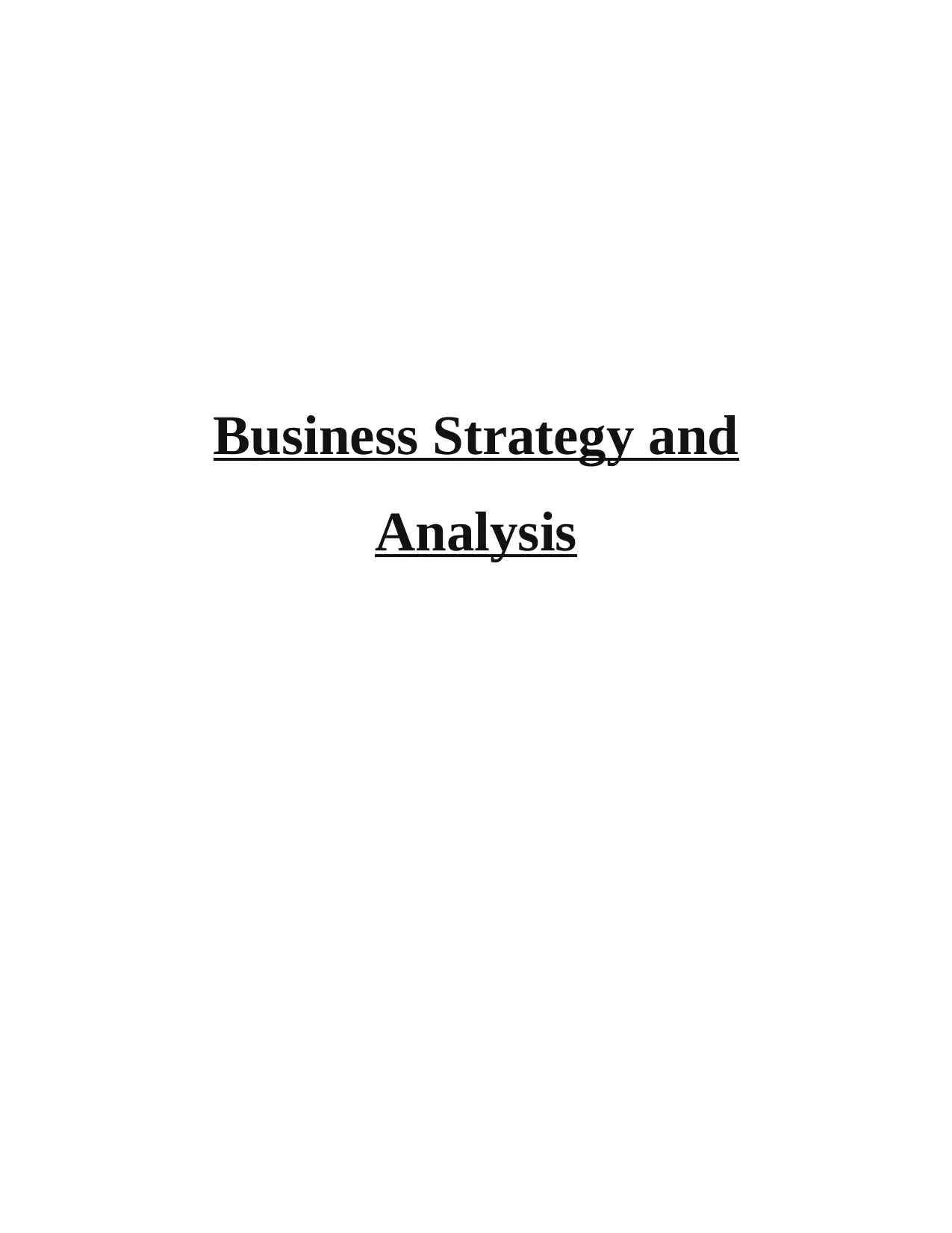
Business Strategy and
Analysis
Analysis
Paraphrase This Document
Need a fresh take? Get an instant paraphrase of this document with our AI Paraphraser
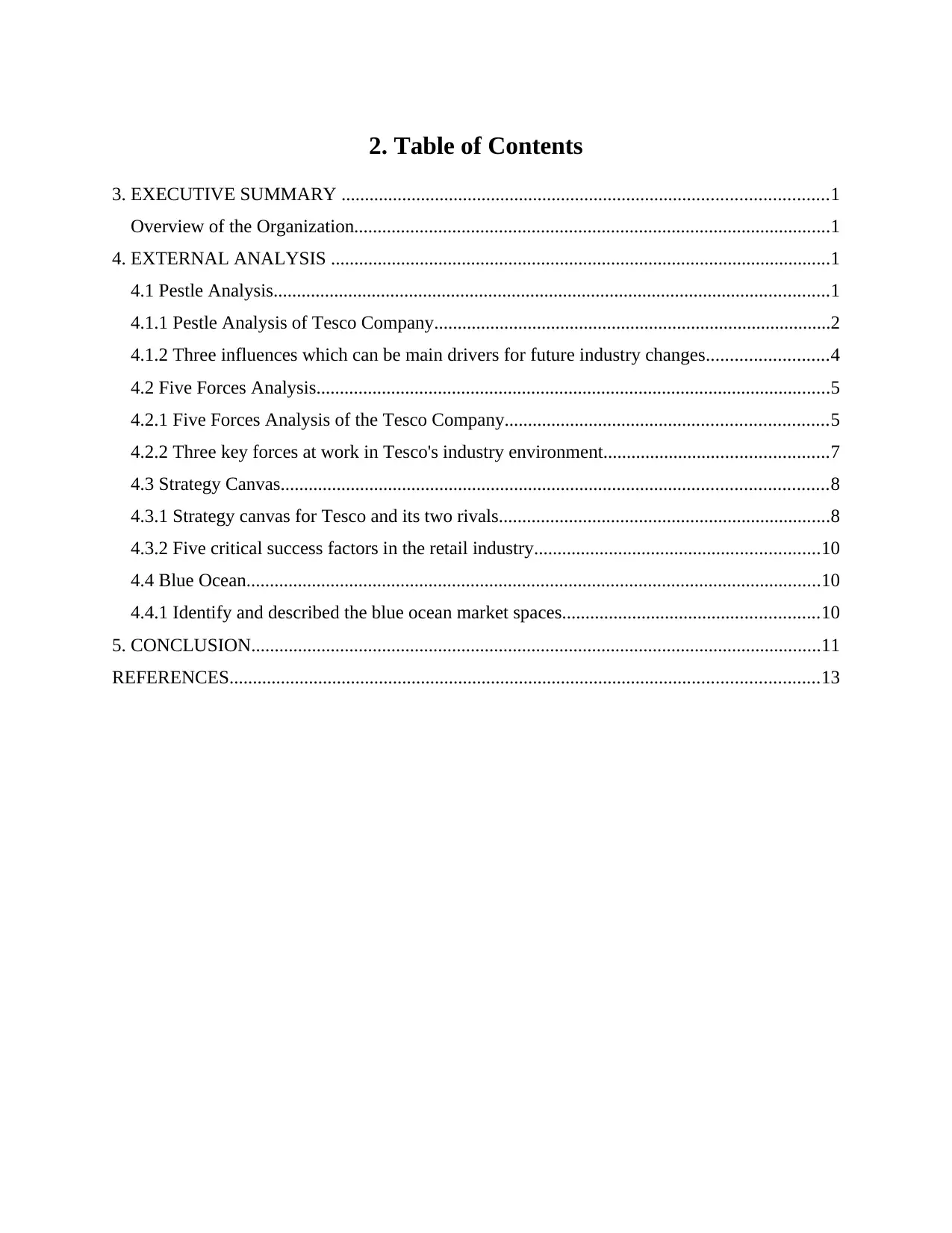
2. Table of Contents
3. EXECUTIVE SUMMARY ........................................................................................................1
Overview of the Organization......................................................................................................1
4. EXTERNAL ANALYSIS ...........................................................................................................1
4.1 Pestle Analysis.......................................................................................................................1
4.1.1 Pestle Analysis of Tesco Company.....................................................................................2
4.1.2 Three influences which can be main drivers for future industry changes..........................4
4.2 Five Forces Analysis..............................................................................................................5
4.2.1 Five Forces Analysis of the Tesco Company.....................................................................5
4.2.2 Three key forces at work in Tesco's industry environment................................................7
4.3 Strategy Canvas.....................................................................................................................8
4.3.1 Strategy canvas for Tesco and its two rivals.......................................................................8
4.3.2 Five critical success factors in the retail industry.............................................................10
4.4 Blue Ocean...........................................................................................................................10
4.4.1 Identify and described the blue ocean market spaces.......................................................10
5. CONCLUSION..........................................................................................................................11
REFERENCES..............................................................................................................................13
3. EXECUTIVE SUMMARY ........................................................................................................1
Overview of the Organization......................................................................................................1
4. EXTERNAL ANALYSIS ...........................................................................................................1
4.1 Pestle Analysis.......................................................................................................................1
4.1.1 Pestle Analysis of Tesco Company.....................................................................................2
4.1.2 Three influences which can be main drivers for future industry changes..........................4
4.2 Five Forces Analysis..............................................................................................................5
4.2.1 Five Forces Analysis of the Tesco Company.....................................................................5
4.2.2 Three key forces at work in Tesco's industry environment................................................7
4.3 Strategy Canvas.....................................................................................................................8
4.3.1 Strategy canvas for Tesco and its two rivals.......................................................................8
4.3.2 Five critical success factors in the retail industry.............................................................10
4.4 Blue Ocean...........................................................................................................................10
4.4.1 Identify and described the blue ocean market spaces.......................................................10
5. CONCLUSION..........................................................................................................................11
REFERENCES..............................................................................................................................13
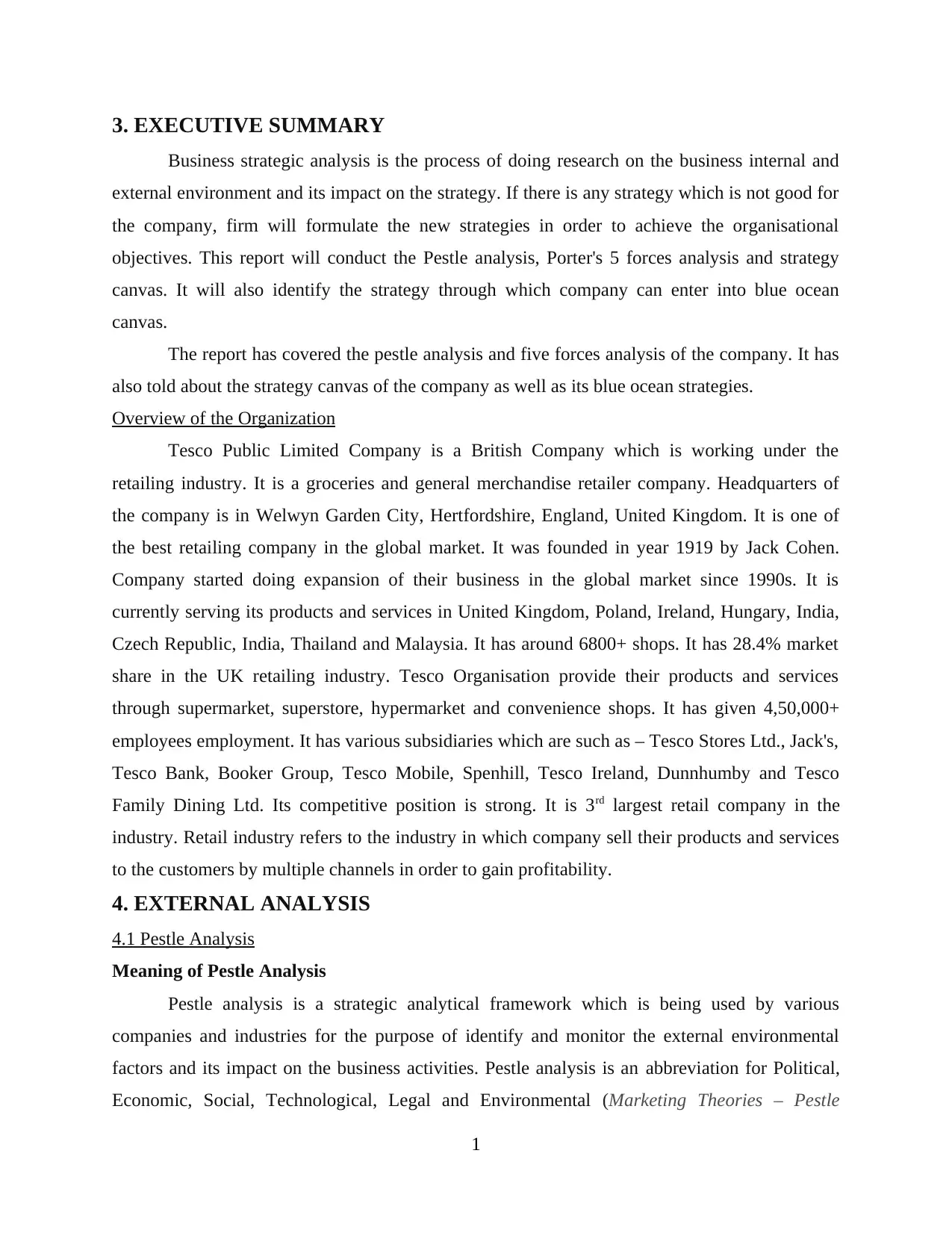
3. EXECUTIVE SUMMARY
Business strategic analysis is the process of doing research on the business internal and
external environment and its impact on the strategy. If there is any strategy which is not good for
the company, firm will formulate the new strategies in order to achieve the organisational
objectives. This report will conduct the Pestle analysis, Porter's 5 forces analysis and strategy
canvas. It will also identify the strategy through which company can enter into blue ocean
canvas.
The report has covered the pestle analysis and five forces analysis of the company. It has
also told about the strategy canvas of the company as well as its blue ocean strategies.
Overview of the Organization
Tesco Public Limited Company is a British Company which is working under the
retailing industry. It is a groceries and general merchandise retailer company. Headquarters of
the company is in Welwyn Garden City, Hertfordshire, England, United Kingdom. It is one of
the best retailing company in the global market. It was founded in year 1919 by Jack Cohen.
Company started doing expansion of their business in the global market since 1990s. It is
currently serving its products and services in United Kingdom, Poland, Ireland, Hungary, India,
Czech Republic, India, Thailand and Malaysia. It has around 6800+ shops. It has 28.4% market
share in the UK retailing industry. Tesco Organisation provide their products and services
through supermarket, superstore, hypermarket and convenience shops. It has given 4,50,000+
employees employment. It has various subsidiaries which are such as – Tesco Stores Ltd., Jack's,
Tesco Bank, Booker Group, Tesco Mobile, Spenhill, Tesco Ireland, Dunnhumby and Tesco
Family Dining Ltd. Its competitive position is strong. It is 3rd largest retail company in the
industry. Retail industry refers to the industry in which company sell their products and services
to the customers by multiple channels in order to gain profitability.
4. EXTERNAL ANALYSIS
4.1 Pestle Analysis
Meaning of Pestle Analysis
Pestle analysis is a strategic analytical framework which is being used by various
companies and industries for the purpose of identify and monitor the external environmental
factors and its impact on the business activities. Pestle analysis is an abbreviation for Political,
Economic, Social, Technological, Legal and Environmental (Marketing Theories – Pestle
1
Business strategic analysis is the process of doing research on the business internal and
external environment and its impact on the strategy. If there is any strategy which is not good for
the company, firm will formulate the new strategies in order to achieve the organisational
objectives. This report will conduct the Pestle analysis, Porter's 5 forces analysis and strategy
canvas. It will also identify the strategy through which company can enter into blue ocean
canvas.
The report has covered the pestle analysis and five forces analysis of the company. It has
also told about the strategy canvas of the company as well as its blue ocean strategies.
Overview of the Organization
Tesco Public Limited Company is a British Company which is working under the
retailing industry. It is a groceries and general merchandise retailer company. Headquarters of
the company is in Welwyn Garden City, Hertfordshire, England, United Kingdom. It is one of
the best retailing company in the global market. It was founded in year 1919 by Jack Cohen.
Company started doing expansion of their business in the global market since 1990s. It is
currently serving its products and services in United Kingdom, Poland, Ireland, Hungary, India,
Czech Republic, India, Thailand and Malaysia. It has around 6800+ shops. It has 28.4% market
share in the UK retailing industry. Tesco Organisation provide their products and services
through supermarket, superstore, hypermarket and convenience shops. It has given 4,50,000+
employees employment. It has various subsidiaries which are such as – Tesco Stores Ltd., Jack's,
Tesco Bank, Booker Group, Tesco Mobile, Spenhill, Tesco Ireland, Dunnhumby and Tesco
Family Dining Ltd. Its competitive position is strong. It is 3rd largest retail company in the
industry. Retail industry refers to the industry in which company sell their products and services
to the customers by multiple channels in order to gain profitability.
4. EXTERNAL ANALYSIS
4.1 Pestle Analysis
Meaning of Pestle Analysis
Pestle analysis is a strategic analytical framework which is being used by various
companies and industries for the purpose of identify and monitor the external environmental
factors and its impact on the business activities. Pestle analysis is an abbreviation for Political,
Economic, Social, Technological, Legal and Environmental (Marketing Theories – Pestle
1
⊘ This is a preview!⊘
Do you want full access?
Subscribe today to unlock all pages.

Trusted by 1+ million students worldwide
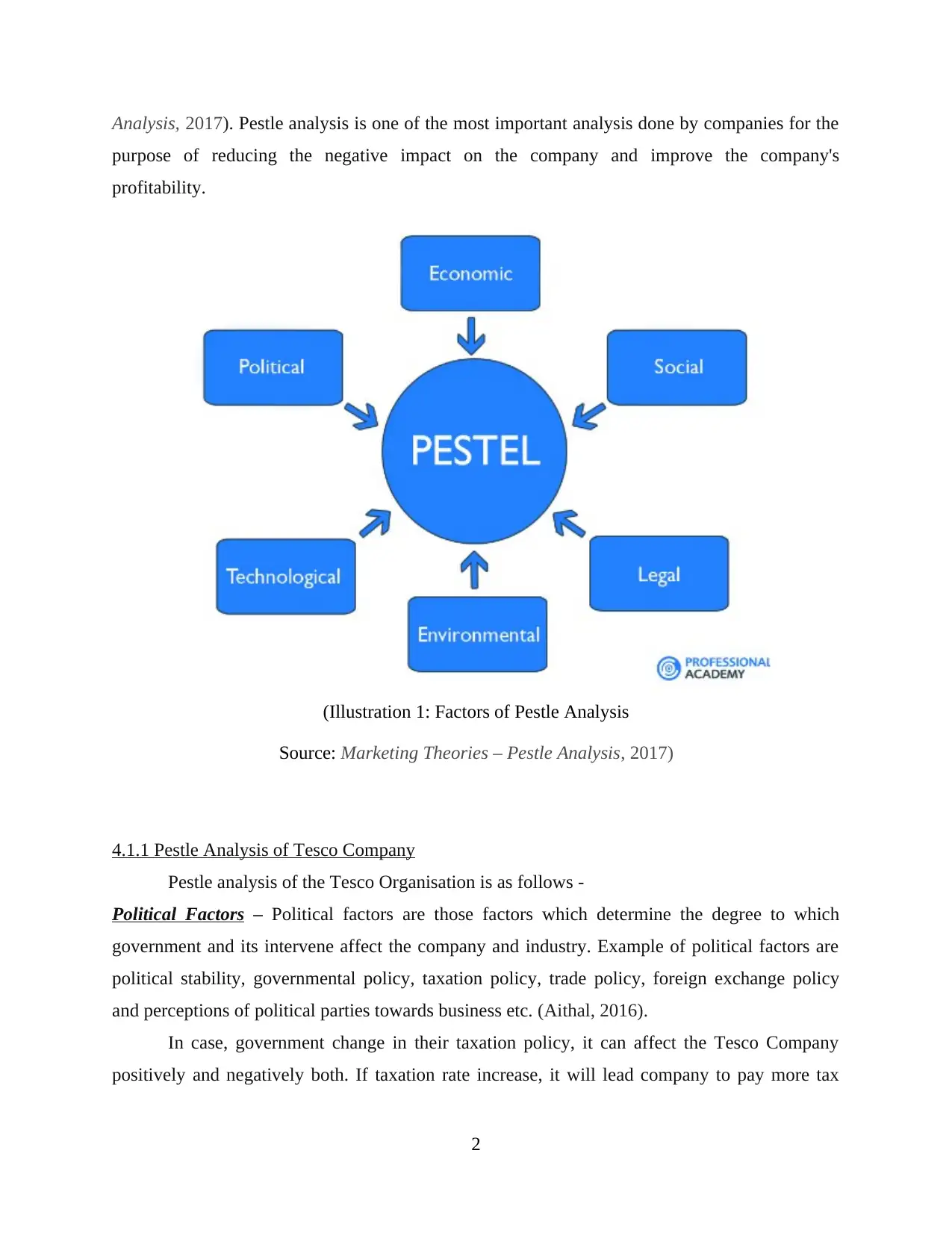
Analysis, 2017). Pestle analysis is one of the most important analysis done by companies for the
purpose of reducing the negative impact on the company and improve the company's
profitability.
4.1.1 Pestle Analysis of Tesco Company
Pestle analysis of the Tesco Organisation is as follows -
Political Factors – Political factors are those factors which determine the degree to which
government and its intervene affect the company and industry. Example of political factors are
political stability, governmental policy, taxation policy, trade policy, foreign exchange policy
and perceptions of political parties towards business etc. (Aithal, 2016).
In case, government change in their taxation policy, it can affect the Tesco Company
positively and negatively both. If taxation rate increase, it will lead company to pay more tax
2
(Illustration 1: Factors of Pestle Analysis
Source: Marketing Theories – Pestle Analysis, 2017)
purpose of reducing the negative impact on the company and improve the company's
profitability.
4.1.1 Pestle Analysis of Tesco Company
Pestle analysis of the Tesco Organisation is as follows -
Political Factors – Political factors are those factors which determine the degree to which
government and its intervene affect the company and industry. Example of political factors are
political stability, governmental policy, taxation policy, trade policy, foreign exchange policy
and perceptions of political parties towards business etc. (Aithal, 2016).
In case, government change in their taxation policy, it can affect the Tesco Company
positively and negatively both. If taxation rate increase, it will lead company to pay more tax
2
(Illustration 1: Factors of Pestle Analysis
Source: Marketing Theories – Pestle Analysis, 2017)
Paraphrase This Document
Need a fresh take? Get an instant paraphrase of this document with our AI Paraphraser
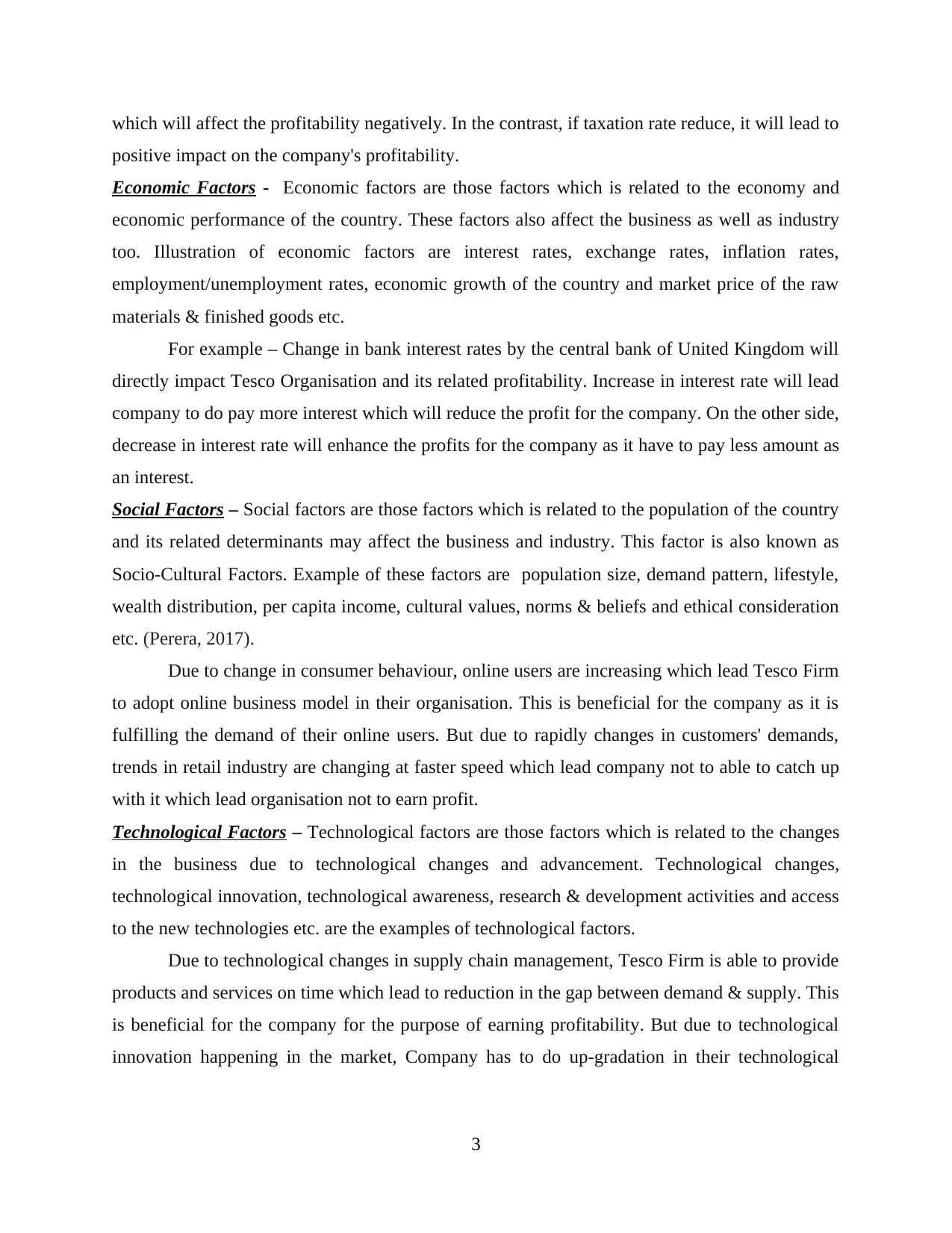
which will affect the profitability negatively. In the contrast, if taxation rate reduce, it will lead to
positive impact on the company's profitability.
Economic Factors - Economic factors are those factors which is related to the economy and
economic performance of the country. These factors also affect the business as well as industry
too. Illustration of economic factors are interest rates, exchange rates, inflation rates,
employment/unemployment rates, economic growth of the country and market price of the raw
materials & finished goods etc.
For example – Change in bank interest rates by the central bank of United Kingdom will
directly impact Tesco Organisation and its related profitability. Increase in interest rate will lead
company to do pay more interest which will reduce the profit for the company. On the other side,
decrease in interest rate will enhance the profits for the company as it have to pay less amount as
an interest.
Social Factors – Social factors are those factors which is related to the population of the country
and its related determinants may affect the business and industry. This factor is also known as
Socio-Cultural Factors. Example of these factors are population size, demand pattern, lifestyle,
wealth distribution, per capita income, cultural values, norms & beliefs and ethical consideration
etc. (Perera, 2017).
Due to change in consumer behaviour, online users are increasing which lead Tesco Firm
to adopt online business model in their organisation. This is beneficial for the company as it is
fulfilling the demand of their online users. But due to rapidly changes in customers' demands,
trends in retail industry are changing at faster speed which lead company not to able to catch up
with it which lead organisation not to earn profit.
Technological Factors – Technological factors are those factors which is related to the changes
in the business due to technological changes and advancement. Technological changes,
technological innovation, technological awareness, research & development activities and access
to the new technologies etc. are the examples of technological factors.
Due to technological changes in supply chain management, Tesco Firm is able to provide
products and services on time which lead to reduction in the gap between demand & supply. This
is beneficial for the company for the purpose of earning profitability. But due to technological
innovation happening in the market, Company has to do up-gradation in their technological
3
positive impact on the company's profitability.
Economic Factors - Economic factors are those factors which is related to the economy and
economic performance of the country. These factors also affect the business as well as industry
too. Illustration of economic factors are interest rates, exchange rates, inflation rates,
employment/unemployment rates, economic growth of the country and market price of the raw
materials & finished goods etc.
For example – Change in bank interest rates by the central bank of United Kingdom will
directly impact Tesco Organisation and its related profitability. Increase in interest rate will lead
company to do pay more interest which will reduce the profit for the company. On the other side,
decrease in interest rate will enhance the profits for the company as it have to pay less amount as
an interest.
Social Factors – Social factors are those factors which is related to the population of the country
and its related determinants may affect the business and industry. This factor is also known as
Socio-Cultural Factors. Example of these factors are population size, demand pattern, lifestyle,
wealth distribution, per capita income, cultural values, norms & beliefs and ethical consideration
etc. (Perera, 2017).
Due to change in consumer behaviour, online users are increasing which lead Tesco Firm
to adopt online business model in their organisation. This is beneficial for the company as it is
fulfilling the demand of their online users. But due to rapidly changes in customers' demands,
trends in retail industry are changing at faster speed which lead company not to able to catch up
with it which lead organisation not to earn profit.
Technological Factors – Technological factors are those factors which is related to the changes
in the business due to technological changes and advancement. Technological changes,
technological innovation, technological awareness, research & development activities and access
to the new technologies etc. are the examples of technological factors.
Due to technological changes in supply chain management, Tesco Firm is able to provide
products and services on time which lead to reduction in the gap between demand & supply. This
is beneficial for the company for the purpose of earning profitability. But due to technological
innovation happening in the market, Company has to do up-gradation in their technological
3
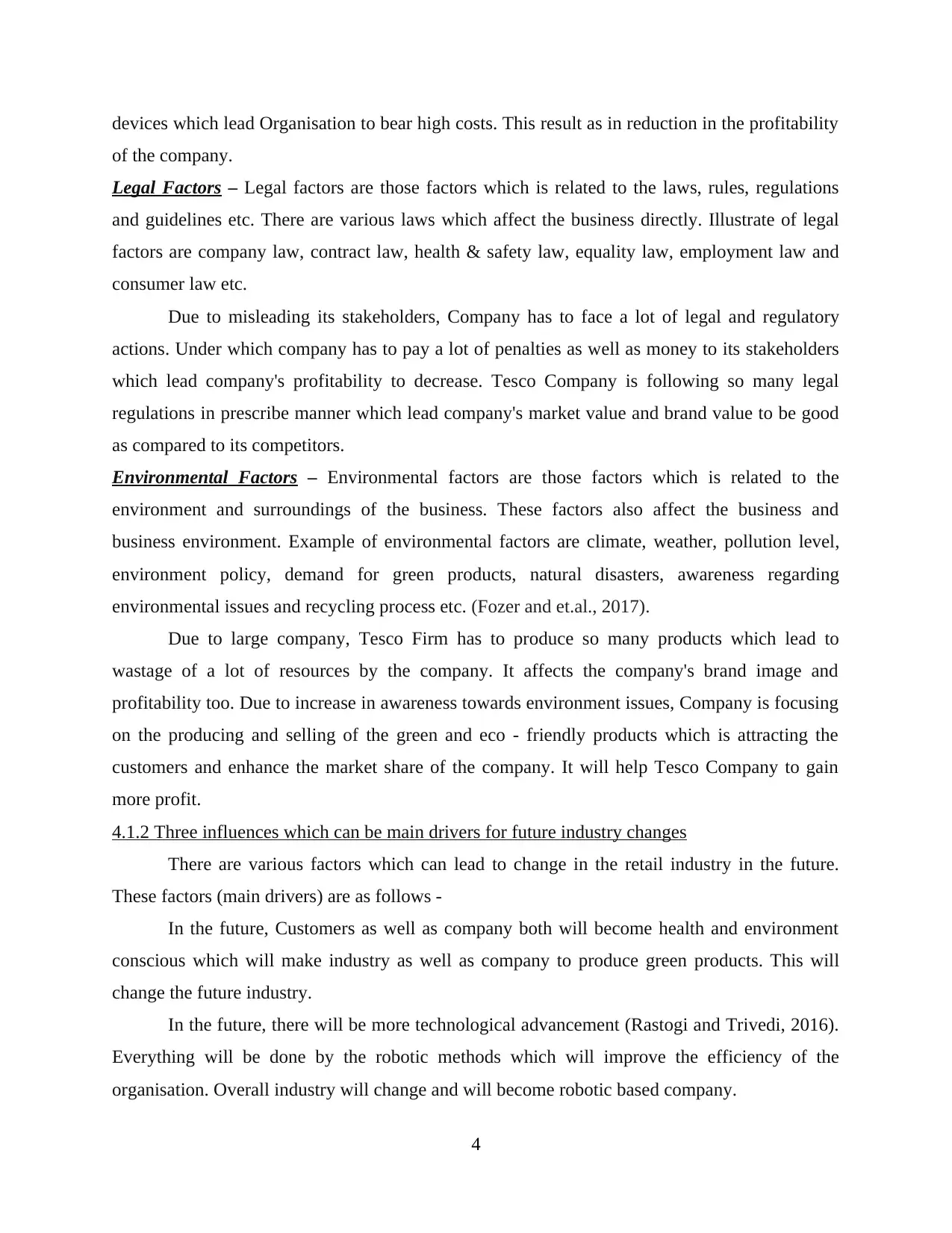
devices which lead Organisation to bear high costs. This result as in reduction in the profitability
of the company.
Legal Factors – Legal factors are those factors which is related to the laws, rules, regulations
and guidelines etc. There are various laws which affect the business directly. Illustrate of legal
factors are company law, contract law, health & safety law, equality law, employment law and
consumer law etc.
Due to misleading its stakeholders, Company has to face a lot of legal and regulatory
actions. Under which company has to pay a lot of penalties as well as money to its stakeholders
which lead company's profitability to decrease. Tesco Company is following so many legal
regulations in prescribe manner which lead company's market value and brand value to be good
as compared to its competitors.
Environmental Factors – Environmental factors are those factors which is related to the
environment and surroundings of the business. These factors also affect the business and
business environment. Example of environmental factors are climate, weather, pollution level,
environment policy, demand for green products, natural disasters, awareness regarding
environmental issues and recycling process etc. (Fozer and et.al., 2017).
Due to large company, Tesco Firm has to produce so many products which lead to
wastage of a lot of resources by the company. It affects the company's brand image and
profitability too. Due to increase in awareness towards environment issues, Company is focusing
on the producing and selling of the green and eco - friendly products which is attracting the
customers and enhance the market share of the company. It will help Tesco Company to gain
more profit.
4.1.2 Three influences which can be main drivers for future industry changes
There are various factors which can lead to change in the retail industry in the future.
These factors (main drivers) are as follows -
In the future, Customers as well as company both will become health and environment
conscious which will make industry as well as company to produce green products. This will
change the future industry.
In the future, there will be more technological advancement (Rastogi and Trivedi, 2016).
Everything will be done by the robotic methods which will improve the efficiency of the
organisation. Overall industry will change and will become robotic based company.
4
of the company.
Legal Factors – Legal factors are those factors which is related to the laws, rules, regulations
and guidelines etc. There are various laws which affect the business directly. Illustrate of legal
factors are company law, contract law, health & safety law, equality law, employment law and
consumer law etc.
Due to misleading its stakeholders, Company has to face a lot of legal and regulatory
actions. Under which company has to pay a lot of penalties as well as money to its stakeholders
which lead company's profitability to decrease. Tesco Company is following so many legal
regulations in prescribe manner which lead company's market value and brand value to be good
as compared to its competitors.
Environmental Factors – Environmental factors are those factors which is related to the
environment and surroundings of the business. These factors also affect the business and
business environment. Example of environmental factors are climate, weather, pollution level,
environment policy, demand for green products, natural disasters, awareness regarding
environmental issues and recycling process etc. (Fozer and et.al., 2017).
Due to large company, Tesco Firm has to produce so many products which lead to
wastage of a lot of resources by the company. It affects the company's brand image and
profitability too. Due to increase in awareness towards environment issues, Company is focusing
on the producing and selling of the green and eco - friendly products which is attracting the
customers and enhance the market share of the company. It will help Tesco Company to gain
more profit.
4.1.2 Three influences which can be main drivers for future industry changes
There are various factors which can lead to change in the retail industry in the future.
These factors (main drivers) are as follows -
In the future, Customers as well as company both will become health and environment
conscious which will make industry as well as company to produce green products. This will
change the future industry.
In the future, there will be more technological advancement (Rastogi and Trivedi, 2016).
Everything will be done by the robotic methods which will improve the efficiency of the
organisation. Overall industry will change and will become robotic based company.
4
⊘ This is a preview!⊘
Do you want full access?
Subscribe today to unlock all pages.

Trusted by 1+ million students worldwide
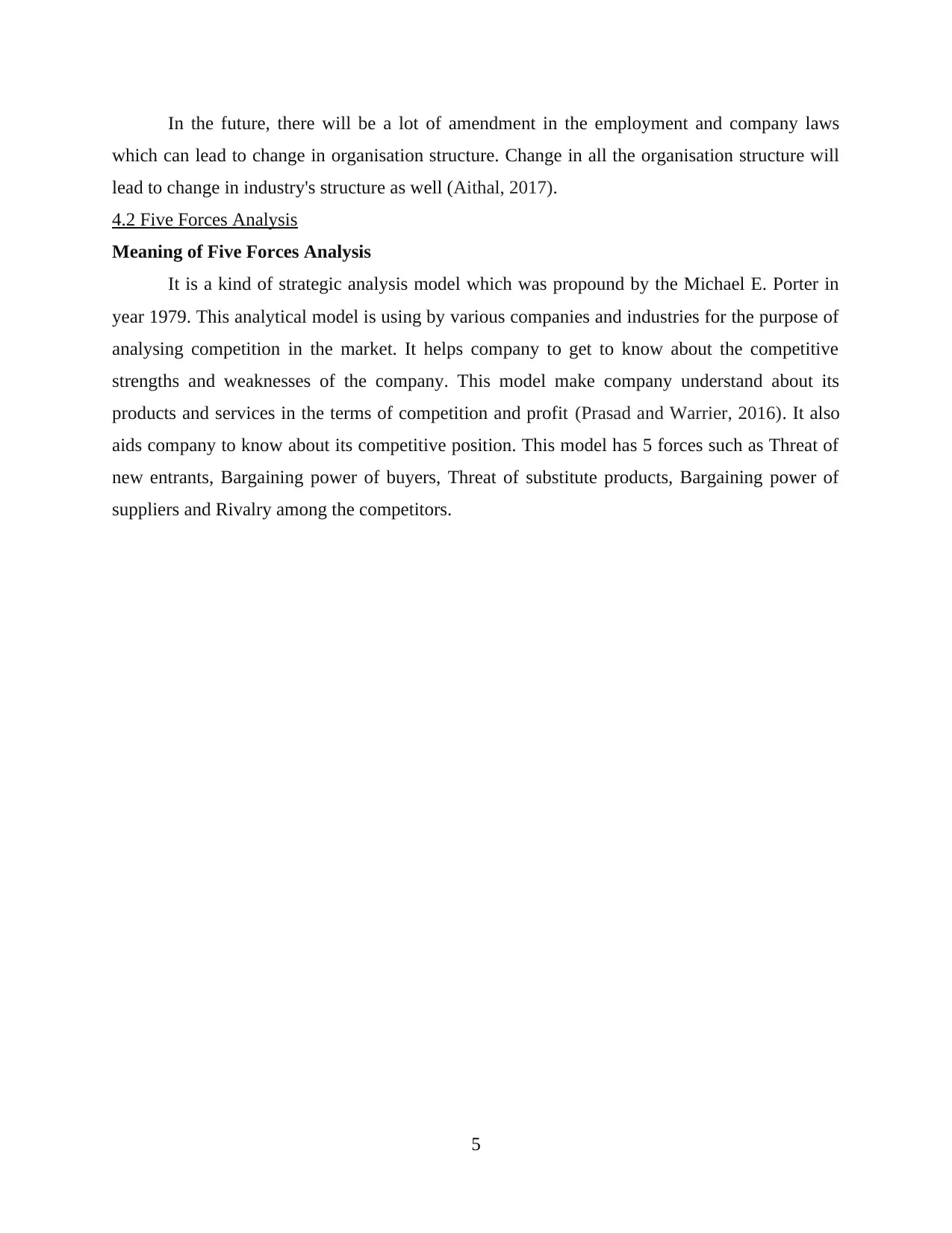
In the future, there will be a lot of amendment in the employment and company laws
which can lead to change in organisation structure. Change in all the organisation structure will
lead to change in industry's structure as well (Aithal, 2017).
4.2 Five Forces Analysis
Meaning of Five Forces Analysis
It is a kind of strategic analysis model which was propound by the Michael E. Porter in
year 1979. This analytical model is using by various companies and industries for the purpose of
analysing competition in the market. It helps company to get to know about the competitive
strengths and weaknesses of the company. This model make company understand about its
products and services in the terms of competition and profit (Prasad and Warrier, 2016). It also
aids company to know about its competitive position. This model has 5 forces such as Threat of
new entrants, Bargaining power of buyers, Threat of substitute products, Bargaining power of
suppliers and Rivalry among the competitors.
5
which can lead to change in organisation structure. Change in all the organisation structure will
lead to change in industry's structure as well (Aithal, 2017).
4.2 Five Forces Analysis
Meaning of Five Forces Analysis
It is a kind of strategic analysis model which was propound by the Michael E. Porter in
year 1979. This analytical model is using by various companies and industries for the purpose of
analysing competition in the market. It helps company to get to know about the competitive
strengths and weaknesses of the company. This model make company understand about its
products and services in the terms of competition and profit (Prasad and Warrier, 2016). It also
aids company to know about its competitive position. This model has 5 forces such as Threat of
new entrants, Bargaining power of buyers, Threat of substitute products, Bargaining power of
suppliers and Rivalry among the competitors.
5
Paraphrase This Document
Need a fresh take? Get an instant paraphrase of this document with our AI Paraphraser
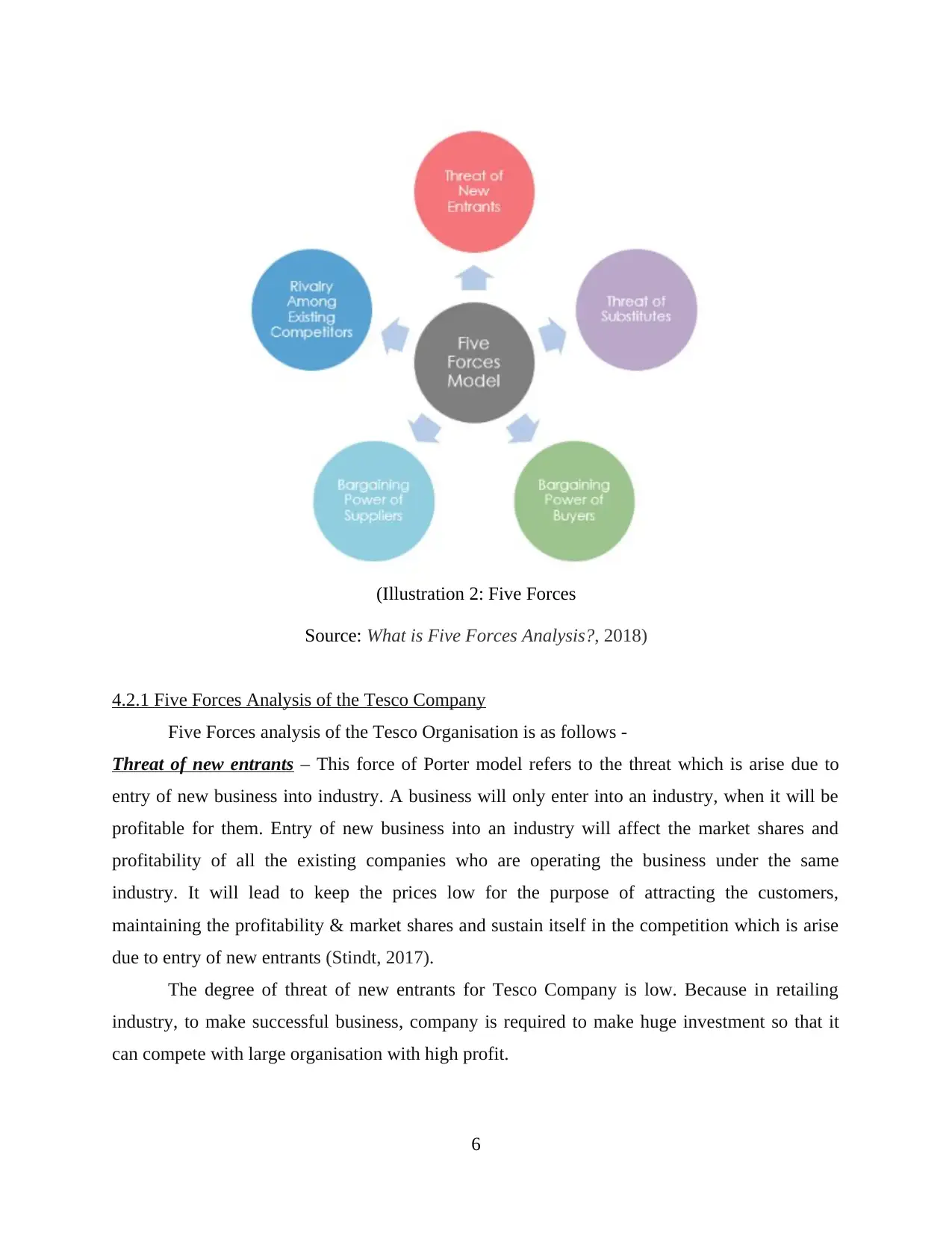
4.2.1 Five Forces Analysis of the Tesco Company
Five Forces analysis of the Tesco Organisation is as follows -
Threat of new entrants – This force of Porter model refers to the threat which is arise due to
entry of new business into industry. A business will only enter into an industry, when it will be
profitable for them. Entry of new business into an industry will affect the market shares and
profitability of all the existing companies who are operating the business under the same
industry. It will lead to keep the prices low for the purpose of attracting the customers,
maintaining the profitability & market shares and sustain itself in the competition which is arise
due to entry of new entrants (Stindt, 2017).
The degree of threat of new entrants for Tesco Company is low. Because in retailing
industry, to make successful business, company is required to make huge investment so that it
can compete with large organisation with high profit.
6
(Illustration 2: Five Forces
Source: What is Five Forces Analysis?, 2018)
Five Forces analysis of the Tesco Organisation is as follows -
Threat of new entrants – This force of Porter model refers to the threat which is arise due to
entry of new business into industry. A business will only enter into an industry, when it will be
profitable for them. Entry of new business into an industry will affect the market shares and
profitability of all the existing companies who are operating the business under the same
industry. It will lead to keep the prices low for the purpose of attracting the customers,
maintaining the profitability & market shares and sustain itself in the competition which is arise
due to entry of new entrants (Stindt, 2017).
The degree of threat of new entrants for Tesco Company is low. Because in retailing
industry, to make successful business, company is required to make huge investment so that it
can compete with large organisation with high profit.
6
(Illustration 2: Five Forces
Source: What is Five Forces Analysis?, 2018)
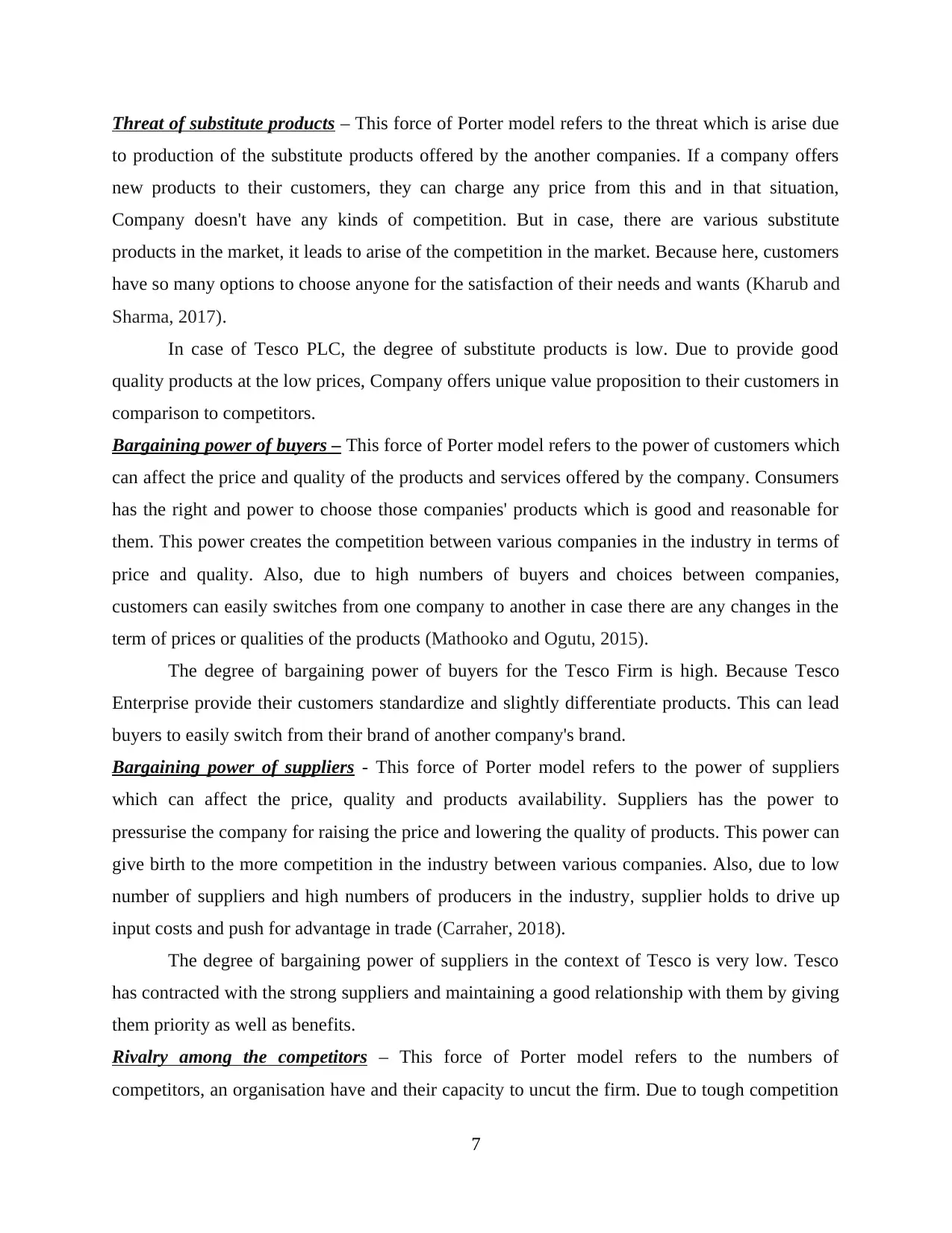
Threat of substitute products – This force of Porter model refers to the threat which is arise due
to production of the substitute products offered by the another companies. If a company offers
new products to their customers, they can charge any price from this and in that situation,
Company doesn't have any kinds of competition. But in case, there are various substitute
products in the market, it leads to arise of the competition in the market. Because here, customers
have so many options to choose anyone for the satisfaction of their needs and wants (Kharub and
Sharma, 2017).
In case of Tesco PLC, the degree of substitute products is low. Due to provide good
quality products at the low prices, Company offers unique value proposition to their customers in
comparison to competitors.
Bargaining power of buyers – This force of Porter model refers to the power of customers which
can affect the price and quality of the products and services offered by the company. Consumers
has the right and power to choose those companies' products which is good and reasonable for
them. This power creates the competition between various companies in the industry in terms of
price and quality. Also, due to high numbers of buyers and choices between companies,
customers can easily switches from one company to another in case there are any changes in the
term of prices or qualities of the products (Mathooko and Ogutu, 2015).
The degree of bargaining power of buyers for the Tesco Firm is high. Because Tesco
Enterprise provide their customers standardize and slightly differentiate products. This can lead
buyers to easily switch from their brand of another company's brand.
Bargaining power of suppliers - This force of Porter model refers to the power of suppliers
which can affect the price, quality and products availability. Suppliers has the power to
pressurise the company for raising the price and lowering the quality of products. This power can
give birth to the more competition in the industry between various companies. Also, due to low
number of suppliers and high numbers of producers in the industry, supplier holds to drive up
input costs and push for advantage in trade (Carraher, 2018).
The degree of bargaining power of suppliers in the context of Tesco is very low. Tesco
has contracted with the strong suppliers and maintaining a good relationship with them by giving
them priority as well as benefits.
Rivalry among the competitors – This force of Porter model refers to the numbers of
competitors, an organisation have and their capacity to uncut the firm. Due to tough competition
7
to production of the substitute products offered by the another companies. If a company offers
new products to their customers, they can charge any price from this and in that situation,
Company doesn't have any kinds of competition. But in case, there are various substitute
products in the market, it leads to arise of the competition in the market. Because here, customers
have so many options to choose anyone for the satisfaction of their needs and wants (Kharub and
Sharma, 2017).
In case of Tesco PLC, the degree of substitute products is low. Due to provide good
quality products at the low prices, Company offers unique value proposition to their customers in
comparison to competitors.
Bargaining power of buyers – This force of Porter model refers to the power of customers which
can affect the price and quality of the products and services offered by the company. Consumers
has the right and power to choose those companies' products which is good and reasonable for
them. This power creates the competition between various companies in the industry in terms of
price and quality. Also, due to high numbers of buyers and choices between companies,
customers can easily switches from one company to another in case there are any changes in the
term of prices or qualities of the products (Mathooko and Ogutu, 2015).
The degree of bargaining power of buyers for the Tesco Firm is high. Because Tesco
Enterprise provide their customers standardize and slightly differentiate products. This can lead
buyers to easily switch from their brand of another company's brand.
Bargaining power of suppliers - This force of Porter model refers to the power of suppliers
which can affect the price, quality and products availability. Suppliers has the power to
pressurise the company for raising the price and lowering the quality of products. This power can
give birth to the more competition in the industry between various companies. Also, due to low
number of suppliers and high numbers of producers in the industry, supplier holds to drive up
input costs and push for advantage in trade (Carraher, 2018).
The degree of bargaining power of suppliers in the context of Tesco is very low. Tesco
has contracted with the strong suppliers and maintaining a good relationship with them by giving
them priority as well as benefits.
Rivalry among the competitors – This force of Porter model refers to the numbers of
competitors, an organisation have and their capacity to uncut the firm. Due to tough competition
7
⊘ This is a preview!⊘
Do you want full access?
Subscribe today to unlock all pages.

Trusted by 1+ million students worldwide
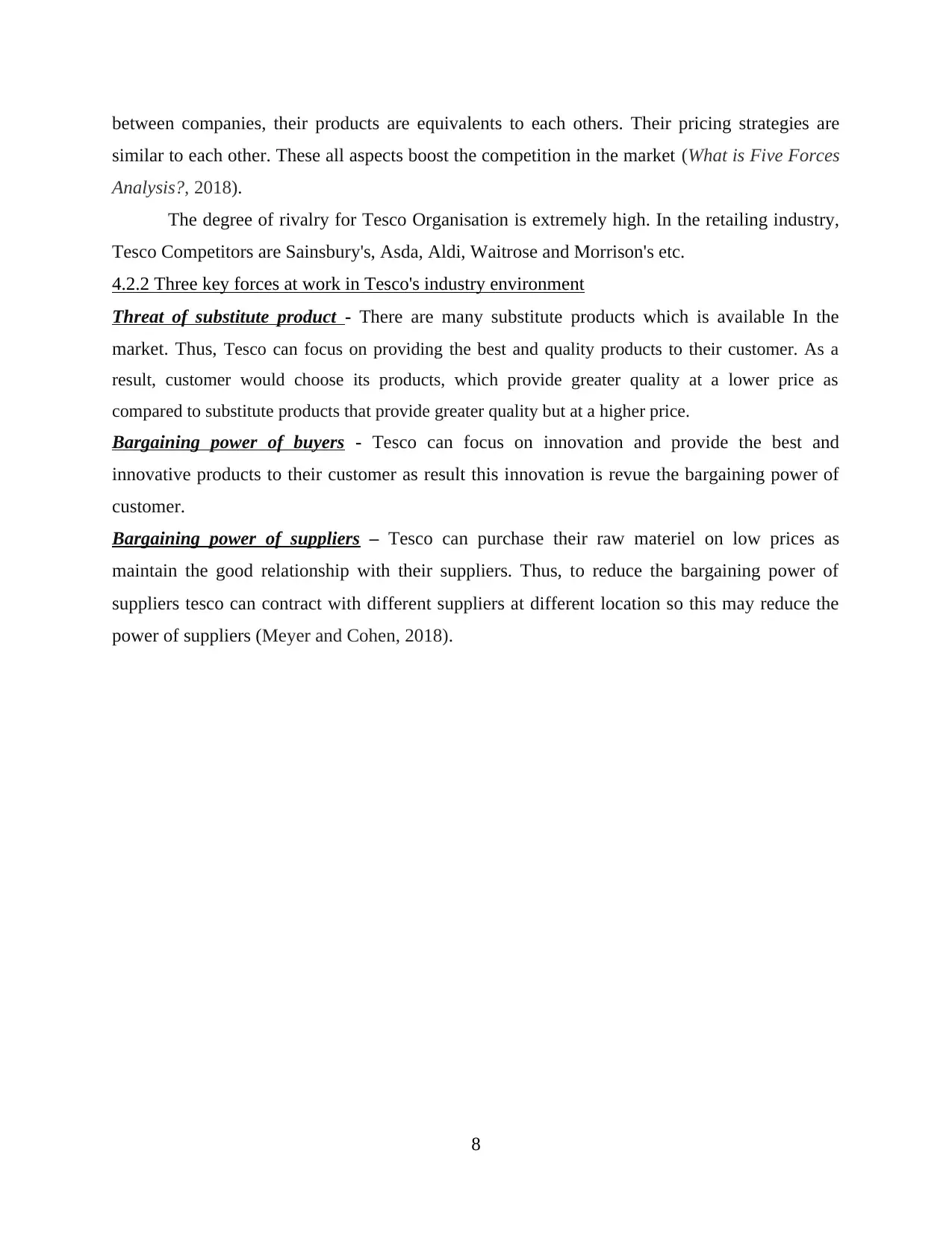
between companies, their products are equivalents to each others. Their pricing strategies are
similar to each other. These all aspects boost the competition in the market (What is Five Forces
Analysis?, 2018).
The degree of rivalry for Tesco Organisation is extremely high. In the retailing industry,
Tesco Competitors are Sainsbury's, Asda, Aldi, Waitrose and Morrison's etc.
4.2.2 Three key forces at work in Tesco's industry environment
Threat of substitute product - There are many substitute products which is available In the
market. Thus, Tesco can focus on providing the best and quality products to their customer. As a
result, customer would choose its products, which provide greater quality at a lower price as
compared to substitute products that provide greater quality but at a higher price.
Bargaining power of buyers - Tesco can focus on innovation and provide the best and
innovative products to their customer as result this innovation is revue the bargaining power of
customer.
Bargaining power of suppliers – Tesco can purchase their raw materiel on low prices as
maintain the good relationship with their suppliers. Thus, to reduce the bargaining power of
suppliers tesco can contract with different suppliers at different location so this may reduce the
power of suppliers (Meyer and Cohen, 2018).
8
similar to each other. These all aspects boost the competition in the market (What is Five Forces
Analysis?, 2018).
The degree of rivalry for Tesco Organisation is extremely high. In the retailing industry,
Tesco Competitors are Sainsbury's, Asda, Aldi, Waitrose and Morrison's etc.
4.2.2 Three key forces at work in Tesco's industry environment
Threat of substitute product - There are many substitute products which is available In the
market. Thus, Tesco can focus on providing the best and quality products to their customer. As a
result, customer would choose its products, which provide greater quality at a lower price as
compared to substitute products that provide greater quality but at a higher price.
Bargaining power of buyers - Tesco can focus on innovation and provide the best and
innovative products to their customer as result this innovation is revue the bargaining power of
customer.
Bargaining power of suppliers – Tesco can purchase their raw materiel on low prices as
maintain the good relationship with their suppliers. Thus, to reduce the bargaining power of
suppliers tesco can contract with different suppliers at different location so this may reduce the
power of suppliers (Meyer and Cohen, 2018).
8
Paraphrase This Document
Need a fresh take? Get an instant paraphrase of this document with our AI Paraphraser
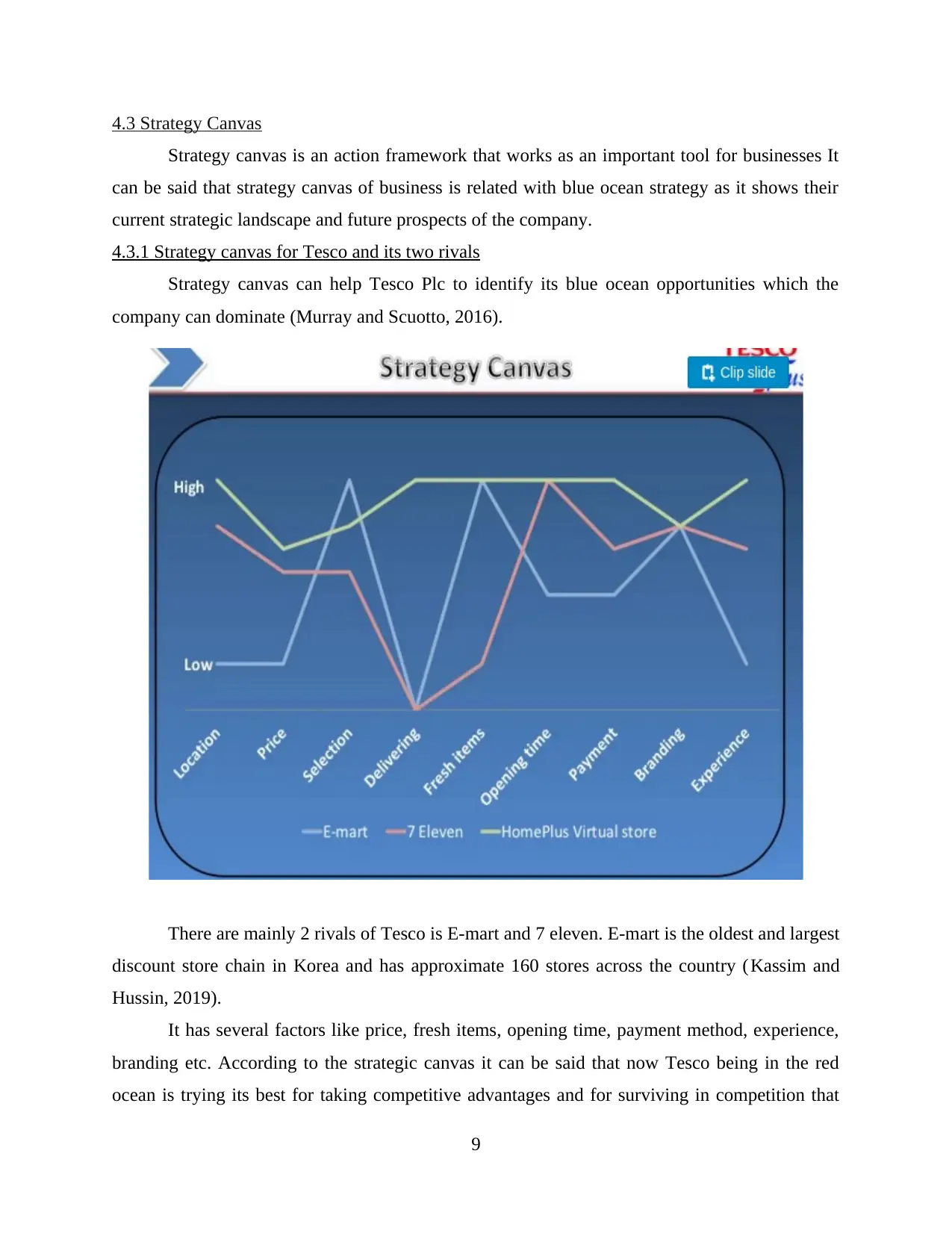
4.3 Strategy Canvas
Strategy canvas is an action framework that works as an important tool for businesses It
can be said that strategy canvas of business is related with blue ocean strategy as it shows their
current strategic landscape and future prospects of the company.
4.3.1 Strategy canvas for Tesco and its two rivals
Strategy canvas can help Tesco Plc to identify its blue ocean opportunities which the
company can dominate (Murray and Scuotto, 2016).
There are mainly 2 rivals of Tesco is E-mart and 7 eleven. E-mart is the oldest and largest
discount store chain in Korea and has approximate 160 stores across the country (Kassim and
Hussin, 2019).
It has several factors like price, fresh items, opening time, payment method, experience,
branding etc. According to the strategic canvas it can be said that now Tesco being in the red
ocean is trying its best for taking competitive advantages and for surviving in competition that
9
Strategy canvas is an action framework that works as an important tool for businesses It
can be said that strategy canvas of business is related with blue ocean strategy as it shows their
current strategic landscape and future prospects of the company.
4.3.1 Strategy canvas for Tesco and its two rivals
Strategy canvas can help Tesco Plc to identify its blue ocean opportunities which the
company can dominate (Murray and Scuotto, 2016).
There are mainly 2 rivals of Tesco is E-mart and 7 eleven. E-mart is the oldest and largest
discount store chain in Korea and has approximate 160 stores across the country (Kassim and
Hussin, 2019).
It has several factors like price, fresh items, opening time, payment method, experience,
branding etc. According to the strategic canvas it can be said that now Tesco being in the red
ocean is trying its best for taking competitive advantages and for surviving in competition that
9
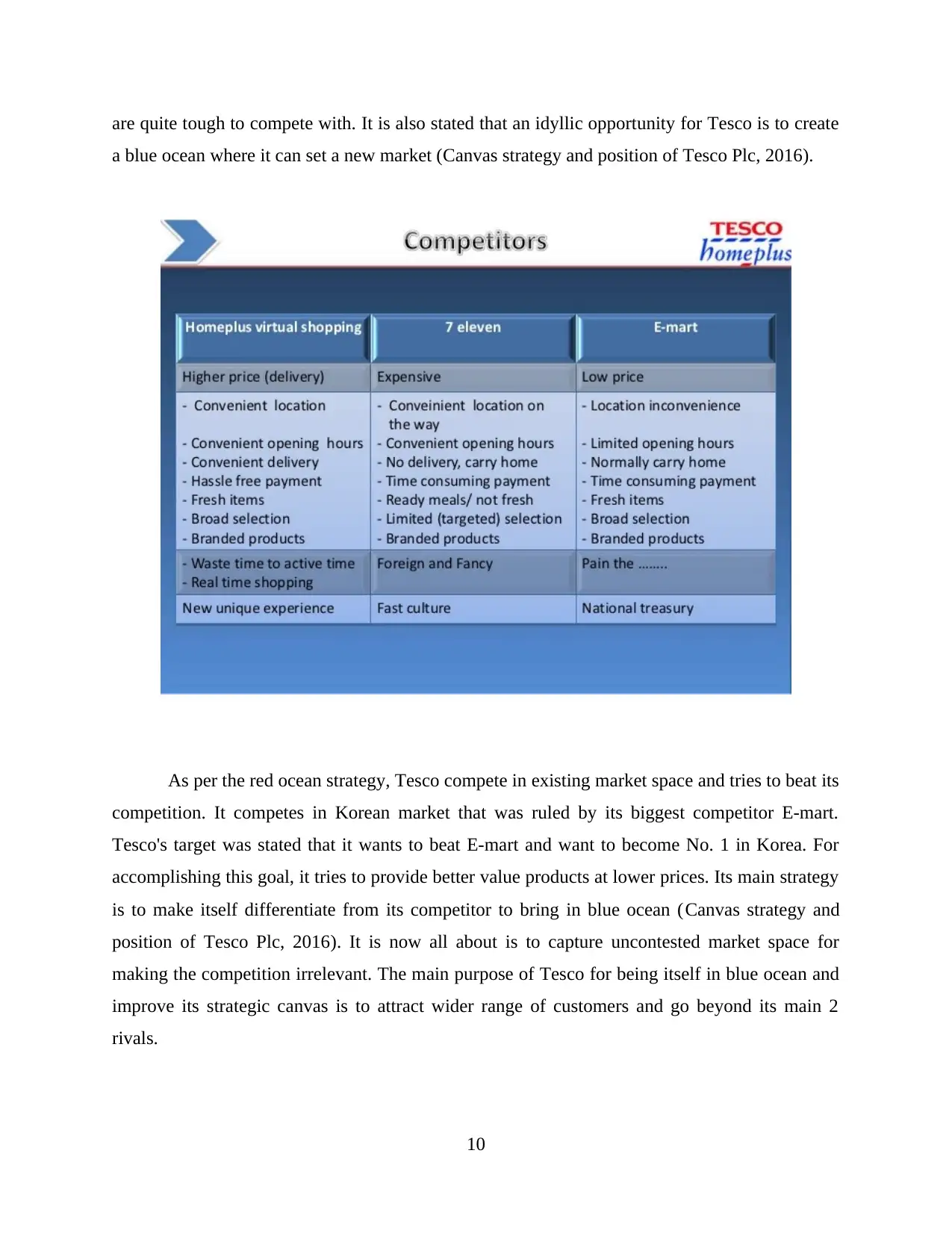
are quite tough to compete with. It is also stated that an idyllic opportunity for Tesco is to create
a blue ocean where it can set a new market (Canvas strategy and position of Tesco Plc, 2016).
As per the red ocean strategy, Tesco compete in existing market space and tries to beat its
competition. It competes in Korean market that was ruled by its biggest competitor E-mart.
Tesco's target was stated that it wants to beat E-mart and want to become No. 1 in Korea. For
accomplishing this goal, it tries to provide better value products at lower prices. Its main strategy
is to make itself differentiate from its competitor to bring in blue ocean (Canvas strategy and
position of Tesco Plc, 2016). It is now all about is to capture uncontested market space for
making the competition irrelevant. The main purpose of Tesco for being itself in blue ocean and
improve its strategic canvas is to attract wider range of customers and go beyond its main 2
rivals.
10
a blue ocean where it can set a new market (Canvas strategy and position of Tesco Plc, 2016).
As per the red ocean strategy, Tesco compete in existing market space and tries to beat its
competition. It competes in Korean market that was ruled by its biggest competitor E-mart.
Tesco's target was stated that it wants to beat E-mart and want to become No. 1 in Korea. For
accomplishing this goal, it tries to provide better value products at lower prices. Its main strategy
is to make itself differentiate from its competitor to bring in blue ocean (Canvas strategy and
position of Tesco Plc, 2016). It is now all about is to capture uncontested market space for
making the competition irrelevant. The main purpose of Tesco for being itself in blue ocean and
improve its strategic canvas is to attract wider range of customers and go beyond its main 2
rivals.
10
⊘ This is a preview!⊘
Do you want full access?
Subscribe today to unlock all pages.

Trusted by 1+ million students worldwide
1 out of 17
Related Documents
Your All-in-One AI-Powered Toolkit for Academic Success.
+13062052269
info@desklib.com
Available 24*7 on WhatsApp / Email
![[object Object]](/_next/static/media/star-bottom.7253800d.svg)
Unlock your academic potential
Copyright © 2020–2025 A2Z Services. All Rights Reserved. Developed and managed by ZUCOL.





